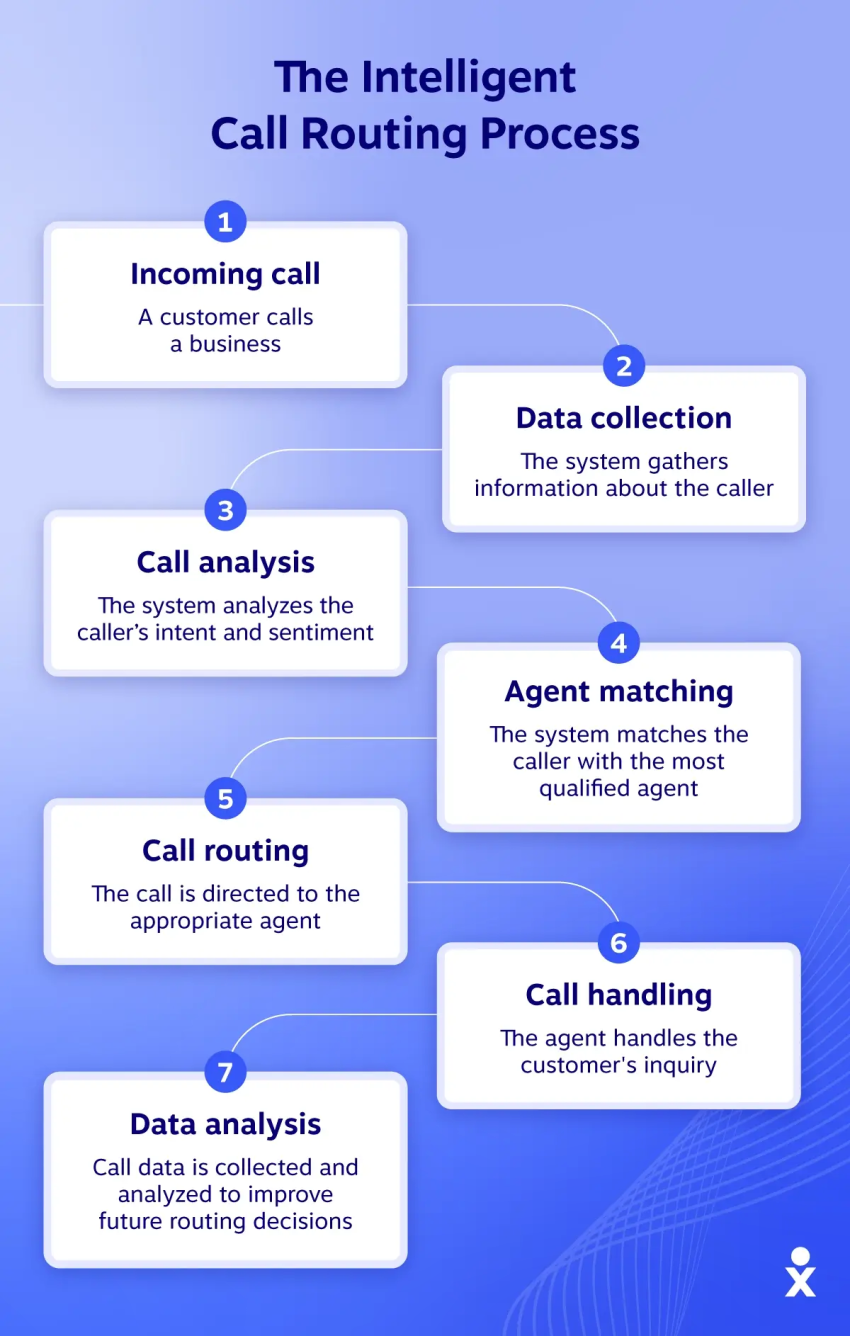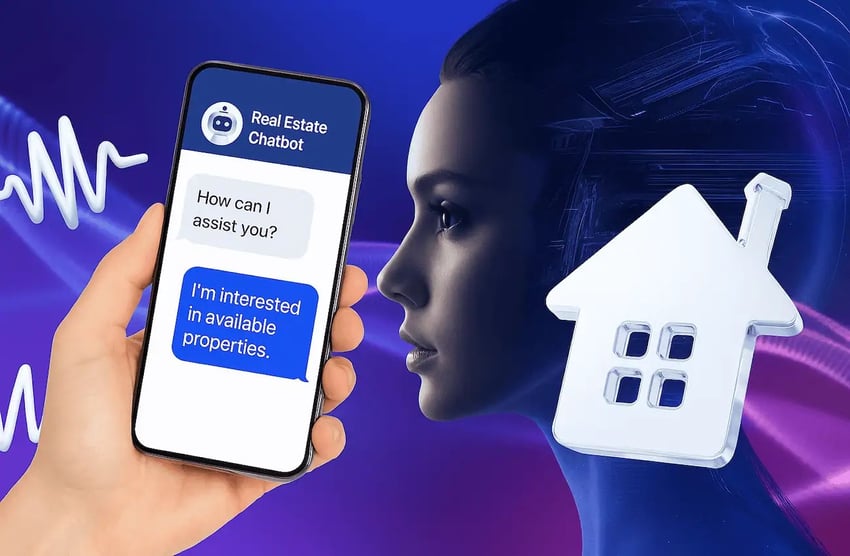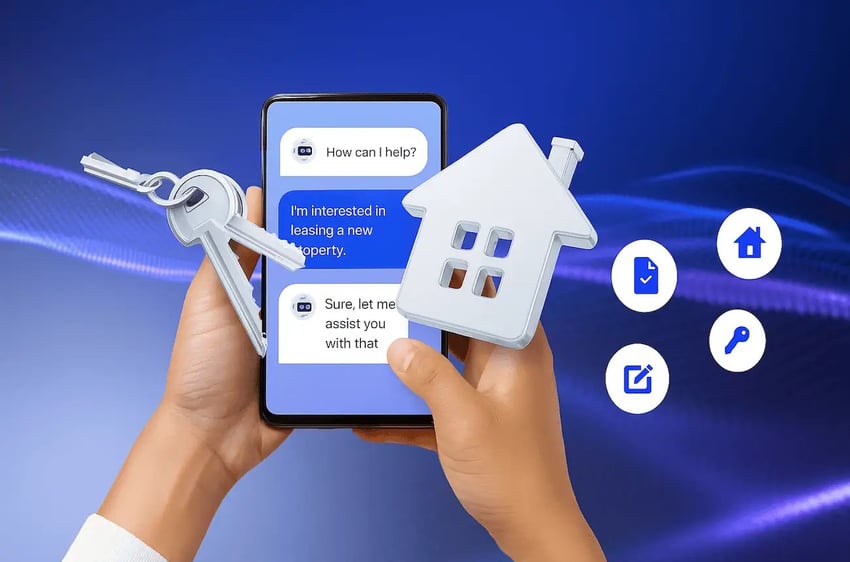You’re running late for an appointment. A basic GPS might give you the shortest route based on distance, but it might not consider traffic conditions, construction, or other factors.
An advanced GPS, however, uses real-time traffic data to suggest the fastest route. It optimizes your journey by considering all of these factors.
Intelligent call routing works much like the advanced GPS. It uses artificial intelligence to analyze call volume, agent availability and expertise, and customer intent and sentiment to direct calls to the most appropriate agent or department.
This guide breaks down everything you need to know about intelligent call routing, from how it works and why it matters to the potential challenges you might come across when setting it up.
What Is Intelligent Call Routing?
Intelligent call routing is an AI-powered technology that directs inbound calls to the most qualified agent or department based on caller information and agent availability.

How Intelligent Routing Works
Intelligent call routing is a system that uses data, analytics, automation, and machine learning algorithms to direct incoming calls to the right agent or department.
Here’s how the process works:
1. Data collection
Intelligent routing systems collect data from multiple sources. This includes real-time information and historical data.
- Real-time data: This comes from the caller’s input through the interactive voice response (IVR) system. It includes things like an account number, reason for the call, or the caller’s location.
- Historical data: This information comes from the company’s database. It includes a customer’s purchase history, account status, and previous interactions with support.
2. Data analysis
After collecting the data, the system analyzes it to understand the caller’s purpose. It compares this data against predefined routing rules and agent expertise, matching the caller with the right agent.
- Caller intent: Natural language processing (NLP) helps the system understand the customer’s request based on their spoken or typed words.
- Agent skills: The system matches the caller’s needs with an agent’s skill set.
- Workload balancing: It makes sure your contact center agents do not get overloaded with calls, distributing them evenly for efficiency.
- Call prioritization: The system can prioritize calls from high-value customers or those with urgent issues.
3. Strategic routing and connection
Based on the analysis, the intelligent call routing software determines the best way to handle the call to meet the customer’s needs. It can use several routing strategies.
- Direct routing: The system sends the call directly to a specific agent.
- Queueing: It places the caller in a call queue, i.e. a virtual waiting line, for the right department.
- Self-service: The system directs the customer to an IVR menu where they can find a solution on their own.
- Callback options: During high-volume times, when all agents are busy, the system can offer to call the customer back, so they can avoid waiting on hold without losing their place in line.
Intelligent Call Routing Pros and Cons
Intelligent call routing improves customer experience by matching each call with the best-suited agent based on the customer’s needs, agent skills, and real-time availability. Your call center will also run more efficiently, with better first call resolution (FCR) rates and reduced call wait times.
At the same time, organizations must address challenges such as getting agent buy-in and investing significant time and resources upfront to set up the system.
The pros:
- Improves first call resolution rates: By matching callers with the agents best equipped to handle their specific issues, intelligent call routing increases the likelihood of resolving inquiries on the first call. This reduces average handle times and builds trust in the brand.
- Boosts operational efficiency: Intelligent call routing reduces unnecessary transfers and minimizes idle agent time. This boosts contact center performance, ensuring agents resolve more calls and reducing operational costs.
- Supports decision-making: Smart call routing gives you actionable insights on call patterns, customer sentiment, and agent performance. You can use this data to identify training gaps, adjust staffing, and optimize routing rules.
- Increases customer satisfaction: Faster connections, fewer transfers, and conversations with the well-trained agents mean a smoother, more satisfying customer journey. So all of your customer engagement metrics, like CSAT and NPS, also get a boost.
- Reduces call wait times: By routing calls based on real-time agent availability and skill, automatic call routing minimizes customer hold times without overloading any single agent. A win-win for agents and customers alike.
- Streamlines workflows: Smart call routing automates call distribution, allowing agents to focus on customer interactions rather than manual routing processes.
- Maximizes agent expertise: Skills-based call routing ensures that each agent works in their area of strength. This improves agent performance and ensures customers receive the best possible support.
- Provides agents with critical context: Intelligent call routing systems can provide agents with a comprehensive view of important customer context, such as account activity, interaction history, resolved tickets, and previous payments. This is everything an agent needs to resolve calls quickly.
The cons:
- Change management challenges: Agents may not understand how the new routing system works. This can cause frustration and resistance to the change of established call center workflows. You must train your team and get their support early.
- Caller interpretation: Customers might not explain their issue in a way the system can understand. This can cause misrouted calls and create a poor customer experience.
- Not conversational: The system is good at sorting calls but lacks the nuance of a human conversation. It cannot adapt to unexpected situations. The system might not provide the full context an agent needs to show empathy and authenticity.
- Not much personalization: While automatic call routing leverages data to tailor interactions, it might not be able to provide human agents with the nuanced context they need to approach customers with authenticity and empathy.
“Identifying the best ways for AI and humans to work together to achieve collective intelligence will become increasingly important.”
– Diyi Yang, assistant professor of computer science at Stanford University
And that’s also how you address the cons and amplify the pros of AI-powered call centers. You use AI for efficiency and insights, but keep humans available to validate decisions and manage risk.
Best Practices for Intelligent Call Routing
Transitioning from traditional automatic call distribution (ACD) to AI-powered call routing can improve customer experience and agent productivity. But this is only if you are intentional in how you implement it and strategic in how you use it.
Here are some best practices to help you set up for success:
Integrate with your existing call routing systems
Integrating your ICR system with existing cloud-based call routing systems, like IVR, is the first step toward setting up an efficient call routing. This ensures customer calls are filtered and pre-processed before reaching agents.
IVR call routing can collect basic information, verify account details, and identify the reason for the call. This gives intelligent call routing the context it needs to connect callers to the right agent efficiently, reducing transfers, wait times, and frustration for both customers and agents.
But don’t just stop there. Connect your ICR with tools like CRM, workforce management platforms, and knowledge bases to get a full view of customers, agents, and customer service operations.
This helps AI make smarter routing decisions by factoring in an agent’s skills and availability and a customer’s history and service agreement. Bringing together all your data sources also gives AI more context to analyze customer sentiment, account value, and past resolution patterns.
Use advanced reporting and analytics
Many organizations collect data without a clear framework on how to use it. Tracking key performance indicators (KPIs) and customer service metrics alone is not enough. You need a system that turns insights into measurable improvements.
Use advanced reporting to go beyond surface-level numbers and look for connections. For example, dig into how routing accuracy affects first call resolution rates, agent satisfaction, and customer effort. This multi-dimensional view shows the real impact of your intelligent call routing system.
When McKinsey surveyed 260 businesses in the United States, 93 percent said they used survey-based metrics to measure customer experience. Only six percent said they could use those results to make strategic or tactical decisions.
Low response rates, unclear data, and no way to link results to financial value make surveys less useful for many companies. In fact, some of the more enterprise organizations are going beyond surveys. They use the data they already have for deeper analytics and predictive insights.
Evaluate and assign agent strengths, skills, and expertise
A key component of successful intelligent call routing is assessing an agent’s strengths, skills, and expertise. Even advanced routing algorithms can fail without accurate skill mapping, leading to frustrated customers and missed business opportunities.
Agent assessment also supports workforce development and retention. Agents working within their strengths are more satisfied and less likely to burn out. Clear skill profiles highlight training needs and career paths, keeping teams engaged and stable.
We suggest evaluating agents across multiple dimensions. Look beyond resolution rates to customer satisfaction, escalation patterns, handle times, and soft skills. Once you have the numbers, bring in the agent and their manager to get a qualitative skill analysis. This will uncover the nuances that metrics alone can’t.
Some companies now offer tiered service levels with clear pricing and are upfront about different tiers of customer support. This makes intelligent call routing and agent skills even more critical, especially if you plan to include services like access to experienced and/or onshore agents.
Utilize high-quality data
High-quality, unified data is the foundation of effective intelligent call routing in call centers. Without it, customers get routed to the wrong agents, algorithms make decisions based on outdated profiles, and agent skill assessments become unreliable.
But building this unified data flow is not that easy. According to Deloitte’s 2024 survey, only 13 percent of companies have achieved full data continuity across customer interactions and channels. What they suggest is omnichannel call center software that connects web, chat, SMS, and other digital channels. GenAI can then put together a 360° customer profile and show agents only the information they need.
Start with a core set of customer journey data and build from there. Many organizations struggle with data quality and availability. Even imperfect data can be useful if you validate it and update it regularly. Over time, your system will learn from past customer interactions and routing decisions, improving accuracy.
Establish clear call handling processes
Smart call routing systems need rules for what happens once a call is routed. Should high-value customers skip the queue? Do billing questions go straight to specialists? Does the system send calls to supervisors when wait times pass a set limit?
These are not just routing choices. You need to set rules for cases like when to offer a callback, how long a call rings before moving on, whether voicemail or an announcement plays, and what caller data appears on the agent’s screen.Then there are elements like rule priority and chain reactions. The more you tell your AI, and the more guardrails you set, the better the call handling processes.
Do You Need Intelligent Call Routing In Your Call Center?
Many call centers struggle with inefficiencies like long wait times, multiple transfers, and uneven ticket distribution. This can frustrate customers and overwork agents.
Intelligent call routing helps because it uses data and automation to send the right call to the right agent at the right time.
- Long wait times: Customers often get stuck on hold, which leads to frustration and abandoned calls. Smart call routing can reduce wait times by dynamically routing calls based on agent availability, caller priority, and sentiment analysis.
- Excessive call transfers: Calls frequently bounce between agents, frustrating customers and increasing the customer effort score (CES). But with automatic call routing, you can analyze a caller’s history and issue type, and match them to the right agent, minimizing transfers.
- High First Contact Resolution rates: Smart call routing improves FCR by routing calls to agents with the right expertise and access to relevant customer data so they can resolve queries as soon as possible.
- Agent burnout: Agents can get stressed when handling too many calls or issues outside their expertise. Automatic call routing considers factors like availability and skill to match calls to the most qualified agents and balance workloads.
Intelligent Call Routing Made Easy
Intelligent call routing systems help your business provide fast, quality support. And with omnichannel routing, you can send customer conversations to the right place the first time, so call center agents with the right expertise can handle and resolve more issues more effectively.
Nextiva gives you an advanced IVR system with conversational AI that improves call routing, reduces hold times, and saves you money. Our NLP capabilities are powered by Google Dialogflow and IBM Watson. Skip the robotic phone trees, and let customers talk to our virtual agents in natural language, like they would to a human agent. This way, you can automate customer service while keeping it conversational and customer-centric.
Start calling for just $15/mo.
See why over 100,000 businesses switched to Nextiva. Now you can get it all for $15/month per user.
Intelligent Call Routing FAQs
Intelligent call routing can seem complex, but it doesn’t have to be. Here are answers to some common questions about ICR.
An IVR system is a basic menu-driven system that directs callers based on input, while intelligent call routing methods use advanced algorithms and data analysis to match customers with the most qualified agents, improving customer satisfaction and agent efficiency.
Unlike traditional call routing, which often relies on a simple first-come, first-served system, intelligent call routing uses data and advanced technology. It integrates with your CRM to validate inbound caller information and helps with intelligent contact routing.
Intelligent call routing can also leverage AI-powered bots to triage incoming phone calls and provide initial assistance. Additionally, it can share relevant caller information with agents, allowing for more personalized and efficient interactions.
Setting up an intelligent routing call center takes just a few steps. Start by establishing a modern call flow within your auto attendants. Next, consider connecting multiple auto attendants to handle different call volumes and types.
Finally, partnering with a cloud-based contact center (CCaaS) provider can provide the necessary tools and expertise to build a sophisticated ICR system that benefits from multiple data sources and advanced routing capabilities.
Choosing the best intelligent call routing service depends on your business needs and budget. Consider features, scalability, integration capabilities, customer support, and pricing factors when evaluating different options. Research and compare multiple providers before making a decision.

















 Customer Experience
Customer Experience 











